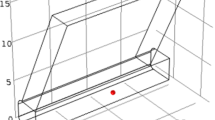Abstract
Cemented paste backfill (CPB) is primarily used for backfilling underground voids at George Fisher Mine (Mount Isa, Australia). The objective of this paper is to summarise the geotechnical characterisation of the tailings and the rheological properties of the CPB as determined from a laboratory testing program undertaken at James Cook University. Two binders were examined [a General Purpose cement and a slag blend cement] over a range of dosages from 0 to 6% and CPB mix solids content in the range of 72–78%. The slump tests were carried out using the standard cone (ASTM C 143) used for concrete and a cylinder with 110 mm (diameter) × 110 mm (height), whereas the yield stress was measured using a shear vane (Brookfield vane spindle V-73). The index characteristics of the tailings including the grain size distribution, liquid limit, plastic limit, specific gravity were determined as per ASTM standards. This paper will then discuss the interrelationships among the solid content, slump, saturated density and the yield stress of the CPB. It is shown that there is strong correlation between the two different slump test devices used in this study. The smaller cylindrical device appears to have good potential for slurries like mine tailings or dredged mud that have high water content for slump test. There is also strong inter-relationship among solid content, slump, yield stress, and bulk density. Increasing the solid content increases the bulk density and yield stress, but reduces the slump. While there is hardly any difference between the two binder types used in this study in terms of flow parameters, namely the yield stress and slump, the binder dosage has an effect. At any specific solid content, higher binder dosages lead to a drop in the slump and increase in the yield stress. The difference is more pronounced in dense slurries. It is also strongly believed that the trends and relationships developed in this study may be valuable for the other mining operations using CPB.














Similar content being viewed by others
References
ASTM (2007) Standard specification for portland cement. ASTM International, West Conshohocken
ASTM (2009) Standard Test Methods for particle-size distribution (gradation) of soils using sieve analysis. ASTM International, West Conshohocken
ASTM (2010) Standard test methods for liquid limit, plastic limit, and plasticity index of soils. ASTM International, West Conshohocken
ASTM (2011) Standard practice for classification of soils for engineering purposes (unified soil classification system). ASTM International, West Conshohocken. https://doi.org/10.1520/d2487-11
ASTM (2014) Standard test methods for specific gravity of soil solids by water pycnometer. ASTM International, West Conshohocken
ASTM (2015a) Standard test method for field vane shear test in saturated fine-grained soils. ASTM International, West Conshohocken
ASTM (2015b) Standard test method for slump of hydraulic-cement concrete. ASTM International, West Conshohocken
Benzaazoua M, Belem T, Bussiere B (2002) Chemical factors that influence the performance of mine sulphidic paste backfill. Cem Concr Res 32:1133–1144
Boger D, Scales P, Sofra F (2006) Rheological concepts. In: Jewell RJ, Fourie AB (eds) Paste and thickened tailings – a guide, 2nd edn. Australian Centre for Geomechanics, Perth, p 25
Chandler JL (1986) The stacking and solar drying process for disposal of bauxite tailings in Jamaica. In: Proceedings of the International Conference on Bauxite Tailings, Kingston, Jamaica, 1986. pp 101–105
Clayton S, Grice TG, Boger DV (2003) Analysis of the slump test for on-site yield stress measurement of mineral suspensions. Int J Miner Process 70:3–21. https://doi.org/10.1016/s0301-7516(02)00148-5
Nguyen QD (1983) Rheology of concentrated bauxite residue. PhD Thesis. The University of Melbourne
Nguyen QD, Boger DV (1983) Yield stress measurement for concentrated suspensions. J Rheol 27:321–349
Nguyen QD, Akroyd T, De Kee DC, Zhu L (2006) Yield stress measurements in suspensions: an inter-laboratory study. Korea Aust Rheol J 18:15–24
Niroshan N, Sivakugan N, Veenstra R (2016) Effects of different binders on the strength and stiffness of paste fills. In: Geo-China 2016, 2016. American Society of Civil Engineers, Shandong, China, pp 197–205. doi:https://doi.org/10.1061/9780784480083.025
Niroshan N, Sivakugan N, Veenstra RL (2017) Laboratory study on strength development in cemented paste backfills. J Mater Civ Eng ASCE 29:04017027. https://doi.org/10.1061/(asce)mt.1943-5533.0001848
Pashias N, Boger D, Summers J, Glenister D (1996) A fifty cent rheometer for yield stress measurement. J Rheol 40:1179–1189
Sivakugan N, Rankine RM, Rankine KJ, Rankine KS (2006) Geotechnical considerations in mine backfilling in Australia. J Clean Prod 14:1168–1175. https://doi.org/10.1016/j.jclepro.2004.06.007
Sivakugan N, Veenstra R, Niroshan N (2015) Underground mine backfilling in australia using paste fills and hydraulic fills. Int J of Geosynth Ground Eng 1:1–7. https://doi.org/10.1007/s40891-015-0020-8
Acknowledgements
The authors thank Liam Shannon, Alex Fairley and Shaun Robinson of Geomechanics Laboratory at James Cook University (JCU) and the postgraduate scholarship to the first author, provided by College of Science and Engineering at JCU, is gratefully acknowledged.
Author information
Authors and Affiliations
Corresponding author
Rights and permissions
About this article
Cite this article
Niroshan, N., Sivakugan, N. & Veenstra, R.L. Flow Characteristics of Cemented Paste Backfill. Geotech Geol Eng 36, 2261–2272 (2018). https://doi.org/10.1007/s10706-018-0460-8
Received:
Accepted:
Published:
Issue Date:
DOI: https://doi.org/10.1007/s10706-018-0460-8




